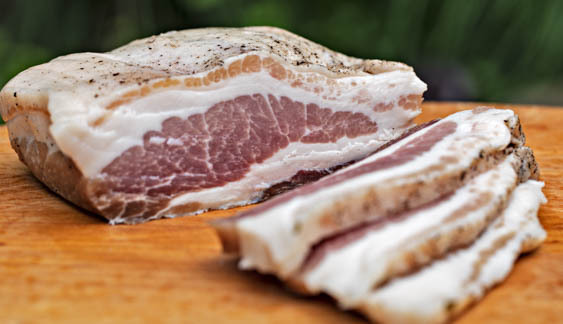Salt-Cured Pork Belly

introduction
When we sautéed off some diced supermarket salt pork for a trial run of Boston Baked Sea Island Peas, the unremarkable aroma issuing from the pan confirmed what the ingredients listed on the label—salt, dextrose, sugar, sodium erythorbate, sodium nitrite—had augured: not much good going on there.
Salt pork originated as way of preserving meat by drawing liquid from fresh pork belly using salt. It is supposed to be rich and unctuous. If ethically sourced and thoughtfully cured, it is an absolute flavor bomb, which, when rendered, imparts a near-silky quality to the sauces and broths it swirls around in—and some meaty bits, too. Salt pork is the sine qua non of baked beans and chowder, that upon which their essential character depends.
We cast off in search of an artisan supplier. None found, we cast off in search of a recipe. And guess what? Salt pork is super easy to make. A nice Berkshire pork belly, some sweet spices, salt, brown sugar, black pepper, and a few days in the fridge gets you a total “value-added” ingredient not only in chowder, baked beans or bean soups, but also with braising greens like collards, green beans, cabbage, and Brussels sprouts. Highly recommended.
Cooking Remarks
This recipe doesn’t aim for doomsday-prepper quantities or curing times. In fact, it uses less salt than many others. We omitted juniper berries from the rub simply because they seemed less compatible with baked beans than nutmeg and clove. To prevent the part of the pork in direct contact with the bottom of the dish from over-curing in its juices, the dry rub application is split over a period of 96 hours.
Dry-cured pork belly becomes its most tender and flavorful when it is first sautéed, then cooked (braised or simmered) in a liquid such as stock, pot likker, or soup. Dry heat is good for rendering fat and crisping, but the pork will be tough until it is braised.
equipment mise en place
For this recipe, you will need a digital kitchen scale, two small bowls, a shallow glass baking dish, cheesecloth, and a zipper-lock plastic bag for storage.
-
-
8ounces fine sea salt
-
1.5ounces brown sugar
-
Pinch of ground cloves
-
Pinch of grated nutmeg
-
1tablespoon crushed black peppercorns
-
3Turkish bay leaves, crumbled
-
3garlic cloves, chopped
-
2pounds boneless, rindless pork belly, patted dry
-
-
In a small bowl, combine the salt, sugar, cloves, and nutmeg and rub together with your fingers. Add the peppercorns, bay leaves, and garlic, then mix well; you should have about ⅔ cup. Measure half of the mixture into another small bowl, cover, and refrigerate for later use.
-
Sprinkle the remaining salt mixture all over the pork and rub it in. Place the pork in a shallow glass baking dish, cover tightly with plastic wrap and refrigerate for 2 days.
-
Remove the pork from the refrigerator and pour off and discard the liquid that has accumulated in the dish. Turn the pork over, sprinkle it all over with the reserved salt mixture and rub it in. Re-cover and refrigerate for another 2 days.
-
Rinse the pork well and thoroughly dry it with paper towels. Wrap it in cheesecloth and store it in a zipper-lock bag in the refrigerator for up to 2 weeks or freeze it.